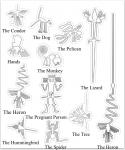Sticker: Nazca Geoglyphs Sheet of 12
One Sticker sheet 127 mm x 152 mm
Featured on each sticker sheet are:
1. Condor
2. Dog
3. Hands
4. 5.Heron, long and short versions
6. Hummingbird
7. Lizard
8. Monkey
9. Pelican
10. Pregnant Person (misnamed The Astronaut)
11. Spider
12. Tree
What are the Nazca line and Geoglyphs?
The Nazca Lines (/ˈnæzkɑː/) are a group of geoglyphs made in the soil of the Nazca Desert in southern Peru. They were created between 500 BCE and 500 CE by people making depressions or shallow incisions in the desert floor, removing pebbles and leaving differently coloured dirt exposed. There are two major phases of the Nazca lines, Paracas phase, from 400 to 200 BCE, and Nazca phase, from 200 BCE to 500 CE. In the years leading up to 2020, between 80 and 100 new figures had been found with the use of drones, and archaeologists believe that there are more to be found.
The lines are typically 10 to 15 cm (4–6 in) deep. They were made by removing the top layer of reddish-brown iron oxide-coated pebbles to reveal a yellow-grey subsoil. Because of its isolation and the dry, windless, stable climate of the plateau, the lines have mostly been preserved naturally.
The figures vary in complexity. Hundreds are simple lines and geometric shapes; more than 70 are zoomorphic designs, including a hummingbird, spider, fish, condor, heron, monkey, lizard, dog, cat, and a human. Other shapes include trees and flowers. The number of known Nazca geoglyphs amounted to 358 in 2022. Drones now are being used to assist the anthropologists researching the area and are expected to enable them to discover many more. They were designated in 1994 as a UNESCO World Heritage Site.
How were they made?
Archaeological surveys have found wooden stakes in the ground at the end of some lines, which supports this theory. One such stake was carbon-dated and was the basis for establishing the age of the design complex.
Joe Nickell, an American investigator of the paranormal, religious artifacts, and folk mysteries, reproduced the figures in the early twenty-first century by using the same tools and technology that would have been available to the Nazca people. In so doing, he refuted the 1969 hypothesis of Erich von Däniken, who suggested that "ancient astronauts" had constructed these works.
Scholars differ in interpreting the purpose of the designs, but in general, they ascribe religious significance to them. Anthropologists, ethnologists, and archaeologists have studied the ancient Nazca culture to try to determine the purpose of the lines and figures. One hypothesis is that the Nazca people created them to be seen by deities in the sky.
The functions and purposes may have been :
* ceremonial
* calendrical
* as venues of events linked to the agriculture calendar
* serving to strengthen social cohesion among various groups of pilgrims, sharing common ancestors and religious beliefs
What are the Threats to the Nazca geoglyphs and lines?
Conservationists who seek to preserve the Nazca Lines are concerned about threats of
* pollution
* erosion caused by deforestation
* rains caused by the climate crisis
* destruction by squatters
* destruction by tourists



